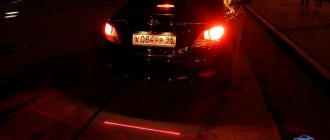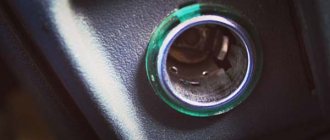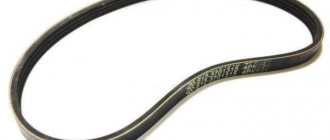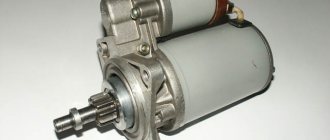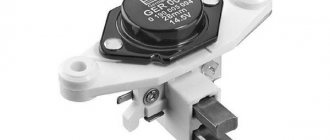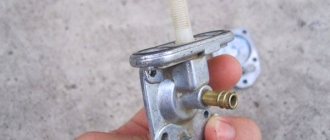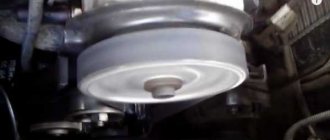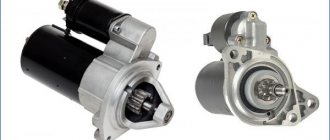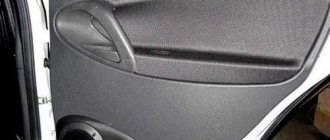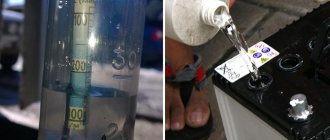On Lada Kalina cars there is an insidious reason that leads to the inability to engage reverse gear. It is interesting that this reason is purely electrical and has nothing to do with mechanics.
Reverse gear on Kalina is engaged by moving the gearshift lever towards you and forward. In this case, you need to lift the plastic ring on the lever. This ring protects the driver from accidentally engaging reverse gear instead of first gear, as often happens on “tens”. This is done using an electric drive - a solenoid.
The solenoid is installed in the transmission and blocks reverse gear from being engaged until the ring on the gear shift lever is lifted. When raised, the reed switch (sealed magnetic switch) in the lever is activated, connects the solenoid power circuit to ground, the solenoid rod is recessed, and the stroke of the gear selection mechanism increases - you can engage the reverse gear.
We will not talk about the advantages and disadvantages of this system. There are two camps of “Kalinovodov”, who are both “for” and “against”. Here we will look at the reasons why problems with electrical locking may arise.
Lockout fuse blown
As always with electrical breakdowns, the first thing we look at is the fuse. Fuse F21, rated 10 A, is responsible for the operation of the reverse locking system in Kalina. It is installed in the main mounting block. If the fuse is intact, then move on to the gear lever. If the fuse jumper is broken, replace it with a new one and see what happens. We try to engage reverse gear. If the fuse blows again, it indicates that there is a short circuit in the solenoid power supply circuit. By
Oil
The gearbox, just like the engine, contains oil. Its viscosity is thicker than motor oil. On domestic cars, the manufacturer recommends changing the fluid at least once every 60 thousand kilometers. If the reverse gear on the Lada Kalina does not engage, check the lubricant level in the box. If the mileage of the car is more than 60 thousand, drain the old fluid and use new one.
Replacing the entire solenoid
In Lada Kalina, the solenoid that is responsible for engaging reverse gear is quite rare, but it can still burn out.
This occurs due to too aggressive use of the gearbox or due to a malfunction of the generator. Moreover, there are cases where the transmission was still engaged with a damaged solenoid, but only periodically. The fault can only be eliminated by completely replacing the solenoid. You should not try to repair it - it has a non-demountable structure, filled with resin from the inside. Why the Lada Kalina engineers used such a solution is anyone's guess.
However, the procedure for replacing it is not complicated; you can do it yourself. To remove the solenoid, you will have to unscrew it from the reverse side. The principle of its operation is the same as that of the central lock. That is, it is the winding that is damaged inside.
tweet
back Test drive the Lada Kalina station wagon
Forward Lada Kalina turned into Granta
Tags: gearbox, transmission, repair, solenoid, clutch
How to change oil
To do this you will need an inspection hole or overpass. Warm up the car before surgery. Transmission oil is very viscous, and at low temperatures it will not completely leave the walls of the box. Locate the drain plug on the transmission. Using a wrench, unscrew it and place a container to drain the waste liquid. Within 20 minutes, all the oil will pour out of the box. Next, tighten the plug with a wrench and find the filler cap. It's on the side.
Backstage adjustment
Often after its repair, the Kalina does not engage reverse gear. The speed at which the pedal is pressed does not matter. Fifth gear will also disappear along with it. To eliminate the malfunction, it is necessary to adjust the position of the rocker. How to do it? You need to find the backstage clamp and loosen it.
Next, the lever is moved to the desired position (reverse or fifth speed). The clamp is tightened. You should check the effectiveness of the adjustment with the engine running. If after this you still cannot engage reverse gear on the Kalina, make the adjustment in first gear. Move the gearbox lever to the appropriate position, having first loosened the bolt. Turn the rocker drive counterclockwise until the lever rests against the reverse gear lock R. By adjusting the seating depth of the rocker on the gearbox driveshaft, you will restore the proper operation of the box.
Solenoids
This mechanism is available on both automatic and manual transmissions. The solenoid is fed through a switch ring (located on the transmission lever). When you pick it up, the element fires. The solenoid rod is pulled inward. Reverse gear is engaged.
At the same time, the limit switch on the gearbox is activated, and the reverse lights turn on. Why doesn't reverse gear engage on Kalina? The reasons may be a blown solenoid fuse. It is marked "F-21". Check the fuse box and replace the burnt element.
Algorithm for determining and debugging the blocking system
Before you start solving the question of why the reverse gear on the Lada “Kalina” does not engage, you should learn a little about the theory of the functioning of the locking system.
Power to the solenoid wiring is supplied through a special switch ring located on the gearshift handle. The principle of operation is as follows: the driver lifts the switch, which activates the solenoids, then the rod is pulled inward. Such actions lead to the fact that the reverse gear is unlocked.
After carrying out such manipulations, the car owner is able to switch the reverse gear; to do this, it is necessary to move the shift knob. Then the “limit switch”, which is located on the box, is activated, and the reverse signals light up, emitting a characteristic sound in the cabin.
To fix the problem you will need the following tools:
- copper wire and soldering iron;
- tester;
- insulating tape (heat shrink);
- wrench marked “36”.
Connection diagram on Kalina
The control circuit for the locking mechanism looks like this - a current of 12 volts passes through a special fuse. It is supplied to the solenoids, after which the circuit is closed using a switch on the lever. Then the solenoid coil starts up.
The debugging procedure occurs according to the following steps:
- the required fuse is located on the safety block on the left side, it is the eighth in the list. You need to get it out and diagnose it using a special tester. If the unit malfunctions, it will need to be replaced;
- We check the switch itself directly. To do this, you will need to lift the cover on the gearbox. Below it is a connector connected to the switch. Unplug slowly and carefully;
- short the contacts using a paper clip. After this, you should try to switch to reverse gear. If the actions lead to the desired result, then the obstacle is a malfunction of the switch. If the rear one does not work, continue to determine the reasons;
- Remove the plug from the solenoid and place 2 pins inside. Next, using diagnostic equipment, measure the voltage. The device should provide information that the voltage level is 12 volts. When connected to a 5-watt light bulb, a light signal should appear. If there are no changes, it means that there are breaks in the wires somewhere. In such a situation, the voltage is due to the resistance generated by the copper oxide. Most often, breaks and refractions are located in the section of the harness where the torpedo is located;
Voltage level measurement
- remove the clamp. To do this, you need to squeeze the latch at the bottom;
- Next you will need to disconnect the plug from the switch. After performing these manipulations, it is possible to pull out the tourniquet completely. Remove the insulating tape from the corrugation and analyze the wiring. If there are breaks or refractions, you will note visual signs;
- damaged wires are removed using wire cutters, and in their place place new ones with the same cross-section and diameter. We recommend soldering the twisted area and applying insulation using heat shrink. If you wish, replace the corrugation with another one. Make sure that moisture does not get on the wiring;
- After connecting all connectors, you can check the functioning of the system.
A broken solenoid is not a common problem. To determine this malfunction, you must connect a tester. When the device operates correctly, it will show 2.2 Ohm data. If the parameters do not match, you will need to drain the car oil from the gearbox.
There is an alternative option without removing the oil, but it requires certain skills and abilities. In such a situation, it is necessary to quickly close the hole through which the substance is escaping and place a new part. After installing the new solenoid, we recommend applying a sealant compound to the threaded area. If you skip this step, the substance will soon begin to flow through the threads.
What to do if it is whole?
If reverse gear does not engage (Lada Kalina), the reasons may lie in another part. To diagnose, you need to disassemble the box cover. Below it there is a connector connected to the solenoid switch. We turn it off and connect the contacts directly. Check to see if reverse gear is engaged. If not, remove the solenoid connector and measure the voltage in it. When the voltmeter shows values less than 12 V, it means there is a short circuit. You can also check using a test lamp. Its power should be from 3 to 5 watts. If it does not light up, it means that the wires in the circuit have burned out. We are looking further. We close the contacts of the connector that goes down under the floor of the car. This can be done using a metal clip. Next, turn on reverse. If it turns on without problems, it means that the short circuit occurred here. If the element is in good condition, remove the connector from the solenoid. Using two pins and a tester, we measure the voltage. The ends of the tester are applied to the pins. In most cases, breakage occurs due to a fracture of the harness and oxidation of copper. Most often, the wire frays at the place where the clamp is installed on the mechanical box pallet. How to check it?
Release bearing
This element is very reliable. But do not rule out its breakdown. How to determine that it is the release bearing that has failed? To do this, you need to squeeze the clutch with the engine running and listen to the operation of the box. If, when you release the pedal, the characteristic sound (rustling) intensifies and the reverse gear on the Kalina does not engage, the reasons are in the bearing. But not only this speed will turn on poorly. Often, due to the “squeeze”, subsequent gears do not work well. They have to be turned on with re-gas and double squeeze.
2 Reed switch and bearing failures – such misfortunes also happen
Let's consider other common reasons that do not allow the use of reverse gear on regular and tuned LADA Kalina 1 and LADA Kalina 2. The reed switch may have flown. The functionality of this element is easy to check. We dismantle the decorative casing above the lever in the car interior and look for its connector. We remove the last one and close the contacts. This operation can be performed using a piece of wire, a paper clip, or any other suitable device at hand.
After mechanically closing the wiring, we try to turn on the reverse gear. If the problem is solved, leave everything as is. We're going about our business. And at the first opportunity we go to a car service and completely change the reed switch. It is impossible to operate a car with the wiring connected according to the specified diagram for a long time. Note that failure of the reed switch is most often caused by rotting of its contacts or the entry of small particles of dirt and debris into the mechanism.
It makes sense to check the reed switch when, when you try to engage reverse, you do not observe any reaction from the car. The gearshift switch simply does not go down, no matter how much pressure you put on it.
If the reverse gear is engaged, but the driver does not hear the characteristic sound with which the additional gear comes into operation, we can safely say that the release bearing is faulty. It usually breaks due to metal filings or waste oil that has penetrated the gearbox mechanism. These pollutants increase the friction force. This causes rapid wear of the bearing, and in some cases leads to combustion of the entire mechanism. The described problem can be solved in one way - you need to install a new bearing.
Why did reverse gear stop turning on and how to solve it
Difficulties engaging reverse gear can arise for a number of reasons, the most common of which are listed below.
The interlock fuse has blown: reason number one
Fuse F21, responsible for blocking reverse gear, is located in the bottom row, in the eighth connector
This is the first element that you need to pay attention to in case of breakdowns related to electronics. In the Lada Kalina car this fuse is designated F21. Its rating is 10 A, and it is located in the main fuse block of the car (there it is eighth from the left). The fuse is removed and its jumper is inspected. If it is broken, the fuse is replaced with a new one. Then the car starts and an attempt is made again to engage reverse gear. If the new fuse blows again, this indicates that there is a short circuit in the solenoid's power supply circuit, therefore, not only the fuse will have to be changed, but also the solenoid itself.
Video about where the fuse box is located in Kalina
The magnetic switch is faulty
The arrow shows the connector that must be closed using a wire or a regular paper clip
This doesn't happen often because the part is quite reliable. The solution is obvious: you need to remove it and check it. To do this, you need to remove the cover mounted on the gear shift lever. Next, you should find the connector that is connected to the lever. It is carefully disconnected, and its contacts are closed with some kind of wire (an ordinary paper clip, which can be attached to the connector with a piece of electrical tape, is also suitable). After closing the contacts, you must try to turn on the reverse gear again. If it succeeds, then the reason was in the magnetic switch, and it needs to be changed. Another option is possible here: the plastic ring itself, to which this switch is connected, does not rise high enough (usually this is due to its wear). So before disassembling the lever and removing the switch, it makes sense to make sure that the ring rises freely and to the required height. If the ring sticks, it must be replaced.
No voltage is supplied from the solenoid to the gear shift lever
The arrow shows a clamp with a frayed wire.
The most common reason. The wire connecting the solenoid and the gear shift lever is located very poorly. It passes under the bottom of the car, near the side member on the left. Here it is affected by moisture, anti-ice chemicals, and finally, it can simply tear due to a falling stone. And most often, this wire breaks where it is attached to the spar with a clamp: dirt accumulates under the clamp, which acts as an abrasive material, literally grinding both the insulation and the wire itself. As a rule, these damages are visible to the naked eye. To identify them, the car is driven into an inspection hole, where an inspection is carried out (in which a flashlight will be very helpful). If the wire is damaged, it is replaced. The second option is also possible: the damage is not visible, and the wire looks intact. In this case, you should use a multimeter to check whether there is voltage at the solenoid output. If it is not there, then the problem is in the wire.
3 Repairing the solenoid - all operations for independent work
We have already told you how to replace the wires leading to the solenoid. Now let's look at the rules for repairing the Kalina locking mechanism. Its malfunction makes it impossible to turn on the rear. To perform this type of repair, you need to look at the solenoid control circuit. It is given below.
Failure of the mechanism in most cases is caused by the failure of fuse F21 (it is rated at 10 A). Through it, as can be seen in the diagram, 12 V is supplied to L1 (solenoid). Then S1 (switch) closes the circuit to ground. As a result of this, the solenoid coil is activated. If the fuse is blown or the switch is faulty, reverse gear will be locked. Let's solve this problem. We take out the fuse (if you look at the left, it will be the eighth one), and check it with a multimeter. Instead of the faulty element, we install a new one (of strictly the same rating - 10 A). When F21 starts working, we work on the switch (see the first section of the article).
If replacing the switch and fuse does not produce results, remove the connector from the solenoid. We put regular pins in it (two pieces). We measure the voltage with a multimeter. With a normally operating mechanism, it is equal to 12 V. If the readings are different, we have a break in the electrical harness on the pallet - at the place where the clamp is mounted. We pull out the entire harness, expose the wires, and eliminate the break. We solder the twisting area and treat it with heat shrink for greater reliability.
In very rare cases, the solenoid itself breaks down. You can check if it is faulty with a multimeter. We connect the device to the solenoid and measure the resistance. If we see a value other than 2.2 Ohm, we will have to change the element. The work is not difficult, but quite dirty. You will need to drain the oil from the gearbox, then remove the old solenoid and install a new one. Before installing a working element, be sure to treat the threads with sealant. It is important. Without this procedure, oil will soon begin to seep through the threads.
Electrical diagram of the LADA KALINA car
Electrical equipment of the Lada Kalina car1 — right headlight; 2 — hood open sensor; 3 — sound signal; 4 — starter Lada Kalina; 5 - battery; 6 — fret generator; 7 — windshield wiper gear motor; 8 — left headlight; 9 — right front door power window switch; 10 — motor-reducer for window lifter of the right front door; 11 — connection blocks to the right front speaker; 12 — electric drive for locking the lock of the right front door; 13 — windshield washer electric motor; 14 — ambient temperature sensor; 15 — block for connecting the wiring harness of the engine control system; 16 — electric drive for locking the left front door lock; 17 — brake fluid level sensor Lada Kalina; 18 — connection blocks to the left front speaker; 19 — power window switch for the right front door, located on the driver’s door; 20 — left front door power window switch; 21 — door lock switch; 22 — motor-reducer for window lifter of the right front door; 23 — mounting block; 24 — control unit for the automobile anti-theft system; 25 — security alarm control unit; 26 — instrument cluster; 27 — right side turn signal; 28 — glove box lighting lamp; 29 — switch for the glove compartment lighting lamp; 30 — brake signal switch; 31 — ignition switch with transponder of the automobile anti-theft system; 32 — control unit for external lighting, instrument lighting and headlight beam direction control; 33 — steering column switch; 34 — left side direction indicator; 35 — connection blocks to the right rear speaker; 36 — electric drive for locking the right rear door; 37 — rear window heating switch; 38 — reverse lock switch; 39 — alarm switch; 40 — heater fan operating mode switch; 41 — additional resistor of the heater fan electric motor; 42 — heater fan electric motor; 43 — connection blocks to the left rear speaker; 44 — electric drive for locking the left rear door; 45 — electric fuel pump with fuel level indicator sensor; 46 — reverse light switch; 47 — parking brake warning switch; 48 — cigarette lighter; 49 — reverse lock solenoid; 50 — connection blocks to the head unit of the sound reproduction system; 51 — backlight lamps for the ventilation and heating system control unit; 52 — electric power steering control unit; 53 — interior lamp; 54 — right rear light of Lada Kalina; 55 — electric drive for locking the trunk lock; 56 — trunk light switch, built into the trunk lid lock; 57 — license plate lights; 58 - additional brake signal; 59 — rear window heating element; 60 — trunk light; 61 - left rear light. This diagram does not show the connection points and wiring harness terminals.
Wiring diagram for connecting the front harness of VAZ 1117, VAZ 1118, VAZ 1119
1,2,3,4- blocks of the front wiring harness to the instrument panel wiring harness; 5 — left headlight; 6 — reverse gear lock solenoid; 7 — reverse light switch; 8-starter; 9 - battery; 10-generator; 11 – blocks of the wiring harness of the battery, starter and front wiring harness; 12- right headlight; 13-electric washer motor; 14 – air temperature sensor; 15 beep; 16 - rear window washer electric motor.
Wiring diagram for connecting the instrument panel harness VAZ 1117, VAZ 1118, VAZ 1119
1.3,4, 5 – blocks of the instrument panel wiring harness to the front wiring harness; 2.6 2.6 — blocks of the instrument panel wiring harness to the rear wiring harness; 7,8,9, 10 – contacts of the mounting block block; 11- lighting control module; 12 — instrument cluster; 13 – heater motor switch; 14 — blocks of the instrument panel wiring harness to the air supply wiring harness; 15 – ignition switch; 16 – anti-theft system block; 17 – block of the instrument panel wiring harness to the ignition system wiring harness; 18 – cigarette lighter; 19 – alarm switch; 20 - rear window heating switch; 21 — stop signal switch; 22 – light signaling switch; 23 – on-board computer mode switch; 24 – wiper switch; 25 – sound signal switch; 26,27 – heating and ventilation control lighting lamps; 28 – lampshade lighting of the glove box; 29 – glove box lighting switch; 30.31 – block of wiring harnesses to the radio; 32 – heater electric motor; 33 – heater resistance; 34 – electric amplifier control unit.
Engine control system wiring harness connection diagram
1 – Lada Kalina ECU; 2 — block of the ECU wiring harness to the instrument panel; 3 - main fuse block; 4 — speed sensor; 5 — rough road sensor; 6 — oil pressure drop warning lamp sensor; 7 — throttle position sensor; 8 — coolant temperature sensor; 9 — coolant temperature indicator sensor; 10 — mass air flow sensor; 11 — idle speed regulator; 12 — electric fuel pump relay; 13 — fuel pump fuse (15A); 14 — ignition relay; 15 — ignition relay fuse (15 A); 16 — ECU power supply fuse (7.5A); 17 — crankshaft position sensor; 18 — control oxygen sensor; 19 — phase sensor; 20 — knock sensor; 21 — solenoid valve for purge of the adsorber; 22 — diagnostic oxygen sensor; 23 — ignition coil; 24 — spark plugs; 25 — nozzles; 26 — ignition coil harness block to the ECU; 27 — ECM wiring harness block to the ignition coil wiring harness; 28 — block of the ECM wiring harness to the injector wiring harness; 29 — block of the injector wiring harness to the ECM harness; A – to the positive terminal of the battery; B1, B2, B3 – grounding points of the ignition system harness; C1 is the grounding point for the ignition coil wiring harness.
Wiring diagram of the rear harness VAZ 1117, VAZ 1118, VAZ 1119
1 — rear harness block to the instrument panel; 2 — block to the wiring harness of the left front door; 3 - to the rear door wiring harness; 4 — right lamp; 5 - to the rear door wiring harness; 6 — to the tailgate wiring harness; 7 - to the instrument panel; 8 — lampshade; 9 — left side direction indicator; 10 — fuel level indicator sensor; 11 — reverse lock switch; 12 - to the right front door; 13 — parking brake sensor; 14 — trunk light; 15 — double-glazed window control unit; 16 — right direction indicator; 17 — left lamp of VAZ 1117, VAZ 1118, VAZ 1119; 18 - to the tailgate.
Continuation of the electrical diagram of the VAZ 1118
CAR ELECTRONICS REPAIR
4 Why reverse gear does not engage - other reasons
If the described methods for restoring the normal functioning of the gearbox did not help, most likely we encountered problems in the mechanical part of the gearbox:
- the spring burst;
- the retaining bolt has been cut off;
- The device that secures the gearbox elements has broken.
These faults are truly complex. Such problems must be solved by car service specialists, since they will need to remove the gearbox, disassemble it, find the cause of the breakdown, and then fix the problem. All this takes more than one hour and requires the use of special tools. It is irrational to carry out such repairs at home.
Training video: The 2181 gearbox can actually work perfectly
Hello dear viburnum growers. I came across a very common problem with our beloved viburnum. Arriving from work in the evening, I parked the car and went home with a calm soul. The next morning, when trying to leave the parking lot, I was unpleasantly surprised: the reverse gear disappeared. At first I was caught in a stupor, because in the evening everything was fine, and in the morning it was already aufiderzein reverse gear, how so? It’s not clear((I had to use public transport. At work, of course, this situation gave me no rest, I started looking for a solution to the problem on the Internet. Whatever they write there, in general, I suffered more than enough fear. In fact, there’s nothing scary at all happened. First you need to figure out the reverse locking circuit, of which there are a great many presented on our beloved Googlenet) The system is indecently simple, a magnetic switch on the switchgear, a contact group on the switchgear, a fuse, a solenoid.
I started with the most basic one, checked fuse f21. It turned out to be correct.
Then I checked the magnetic switch in order, I thought maybe it was him, although the part is quite reliable.
A modern car is literally packed with electronics, and the Lada Kalina is no exception in this sense. On the one hand, electronics make life much easier for the driver. On the other hand, it can also become a cause and source of headaches for the driver, since the abundance of electronics can seriously complicate troubleshooting. The most common electronics-related problem on Kalina is the inability to engage reverse gear. We will tell you why the transmission does not turn on and how to fix it in this article.
